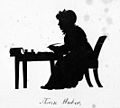University trustees
As Universitätsmamsellen (composite of University and housekeeper for "Miss") Members are called a group of daughters of professors from the University of Göttingen in the 18th and 19th centuries, the literary and academic operated at a time when that was still unusual for women .
Group of people
One of the university trustees is:
- Philippine Engelhard (1756–1831), daughter of Johann Christoph Gatterer ,
- Caroline Schelling (1763–1809), daughter of Johann David Michaelis ,
- Therese Huber (1764–1829), daughter of Christian Gottlob Heyne ,
- Meta Forkel-Liebeskind (1765-1853), daughter of Rudolf Wedekind , and
- Dorothea Schlözer (1770–1825), daughter of August Ludwig von Schlözer
The members of this group were not only familiar with each other from their childhood in Göttingen, but also kept in contact with each other throughout their lives, were themselves in contact with important people of German intellectual life, were literary to varying degrees and thus formed a kind of female network of central connecting points between the Germans Culture around 1800.
Republic of Mainz
A focal point for three members of the group was the Republic of Mainz . The three of them stayed in Mainz in the period 1792/1793 and were each associated with protagonists of political development:
- Therese Forster, who later became Therese Huber, came to Mainz with her husband Georg Forster in 1788 . Georg Forster was elected President of the Jacobin Club on December 31, 1792 and later became a member of the Rhenish-German National Convention . On December 7th, however, his wife separated from him and fled to Strasbourg.
- Caroline Böhmer, who later became Caroline Schelling. She moved to Mainz in March 1792, newly widowed. From December onwards she took care of the household of Forster, who was abandoned by his wife. Her brother-in-law was Georg Wilhelm Böhmer , who was also a prominent Jacobin in Mainz .
- Meta Forkel arrived in Mainz on October 19, where she was accepted by Caroline Böhmer. She was born to an illegitimate son on October 7th. Her brother Georg von Wedekind , who, like Böhmer, was a founding member of the Jacobin Club, lived in Mainz .
When the end of the Republic of Mainz became apparent, Caroline Böhmer and Meta Forkel, who were pregnant by a French officer, and their mother and sister-in-law Wilhelmine Wedekind tried to escape to Frankfurt on March 30, but were arrested by Prussian outposts shortly after Oppenheim . Caroline Böhmer was thought to be Georg Böhmer's wife because of the similarity of names. The women were first brought to Hattersheim , then interrogated in Frankfurt and finally brought to Königstein Fortress . Soemmerring , then a professor in Mainz and a friend of Forster's, reports on the prisoners:
- They have not been interrogated, nor have they been told in any other way the cause of their arrest and their current prison at Koenigstein - I could not bear the sight of these unfortunate people to approach them until I spoke, but turned away and returned home.
They were not released until mid-July. Meta Forkel and her future husband Johann Heinrich Liebeskind made their way to East Prussia, where Liebeskind was to take up his first position.
Caroline Böhmer was persecuted and defamed for a long time. She was not only suspected of Jacobinism, but above all accused of adultery with Georg Forster. A contribution to the damage to their reputation had contributed to a Pasquill published in 1793 under the title Die Mainzer Klubbisten zu Königstein: Or, the women cover each other's shame . The anonymous author, who is relatively well informed about the private circumstances in the Forster house, shows Caroline, Meta Forkel and the Wedekind women in fortress imprisonment on Königstein as loud-mouthed, horny women who have nothing else in mind than chasing each other's men off.
swell
- The Mainz club lists in Königstein. A tragic-comic play in one act. O. V., o. O. 1793 ( digitized version ).
- The Mainz club lists in Königstein. Or, the women expose each other's shame. A tragic-comic play in one act (= Franz Blei (Hrsg.): Deutsche Litteratur-Pasquille. Vol. 4). Reprint of the edition from 1793. Zeitler, Leipzig 1907 ( digitized ).
literature
- Klaus Harpprecht , Gesa Dane: The University Mamsellen. Five ladies from Göttingen, some of whom were beautiful, all of whom were attractive, talented and educated, but certainly as clever as most professors. Deuerlich, Göttingen 1988.
- Eckart Kleßmann : University nurses . Five enlightened women between Rococo, Revolution and Romanticism (= The Other Library. Vol. 281). Eichborn, Frankfurt am Main 2008, ISBN 978-3-8218-4588-3 .
- Annette Lüchow: "A goose of our city". The Göttingen "university mams". In: Georg Christoph Lichtenberg 1742–1799. Risk of enlightenment. Hanser, Munich et al. 1992, ISBN 3-446-17040-5 , pp. 197-201 (exhibition catalog in Darmstadt and Göttingen).
Individual evidence
- ↑ Kleßmann Universitätsmamsellen 2008, p. 196




